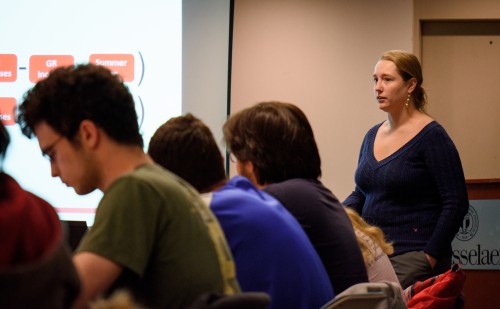 SENATE-EXECUTIVE LIAISON AND CHAIRMAN OF THE UAR COMMITTEE GRADUATE STUDENT JEN CHURCH PRESENTS the UAR for Fiscal Year 2017 for the approval of the Student Senate.
SENATE-EXECUTIVE LIAISON AND CHAIRMAN OF THE UAR COMMITTEE GRADUATE STUDENT JEN CHURCH PRESENTS the UAR for Fiscal Year 2017 for the approval of the Student Senate.With the recent conclusion of the budgeting season, the Union Annual Report for Fiscal Year 2017 was completed. Dating back to 2009, the UAR was first created to describe in detail the budgeting processes taken by members of the Rensselaer Union and the Executive Board. “The UAR is a standing commitment to transparency in the budgeting process, and a right for students to know where their money goes,” according to President of the Union Nick Dvorak’s ’16 letter on page seven. This year’s document is no exception, containing thorough explanations of what the UAR is and where the funds of the student activity fee are going.
The report provides the history of the Union and of the Activity Fee. The narrative supplies the reader with perspective on how the original idea of a student-funded and student-made budget to cover the cost of recreational, student-led programs, still remains relevant to today and is evident in this UAR. The Union manages the budgets of over 160 clubs and over 20 Intercollegiate Athletic teams. Their funds come from the Activity Fee which was determined to be $674 for undergraduates and $361 for graduates. This includes the Union Activity Fee, class dues, and the athletics fee and is a 2.5 percent increase. The joint efforts of the Union Annual Report Committee, Business Administrator, and other Union Administration staff examining the club and athletic budgets, result in this newfound activity fee.
Included in the document is a budgeting timeline. This timeline makes plain what steps of the budgeting process are made during what time. However, due to a mid-year change of responsibility between former Senate-Executive Board Liaison Andrew Sudano ’17 and current Senate-Executive Board Liaison graduate student Jen Church, there were differences in this year’s process, according to current Liaison Church.
“Typically the UAR timeline begins at the end of the Spring semester when the UAR Chair, who is also the Senate-Executive Board Liaison, is appointed. The chairperson begins going to Senate and E-Board meetings and forms a committee. I’m not sure what happened over the summer and early last fall since Andrew Sudano was the chairperson at that point. I do know the Committee was researching reports from large companies to compare to our UAR. When Andrew resigned, I applied for the position and was selected. When speaking with the President of the Union, he mentioned a three-tiered approach to the UAR—a full report, condensed version and a brochure. The Committee began designing the full report and gathering information for the different sections. This continued over winter break. When we returned I was informed of the Institute’s decision to remove the Intercollegiate Athletics budgets from the purview of the Union. At this point we were told we could not write about ICA at all in the UAR, and that the Institute would give us language to put in the report. Following several discussions with Dr. Ross, he agreed it would fit the report to discuss the decision by the Institute in this year’s UAR. The ICA discussion set our timeline for release back by several weeks, so the release had to be pushed out quickly to make the submission deadline. The Senate approved the document on February 17th. Following the Senate vote, the Committee began work on designing the brochure and condensed version,” says Jen Church on the creation process.
The UAR Committee was a team comprised of a variety of different students. Sarah Murguia ’19 told The Poly of her experience of being a part of the creation of this document. “The UAR requires a lot of knowledge of the Union, so as a freshman it was a little challenging to work on because there was much I didn’t know. Luckily, everyone on the team knew a lot about the Union and its processes.”
The UAR holds line by line details of how much is spent and on what it is spent. For students interested in reviewing the document themselves, visit http://poly.news/s/qh4rk/.
